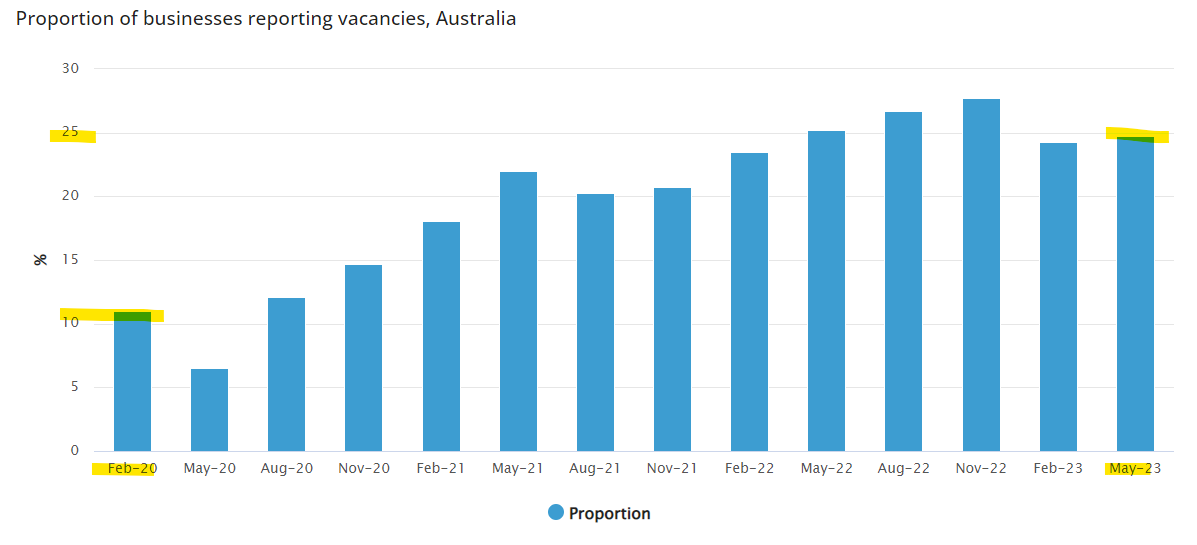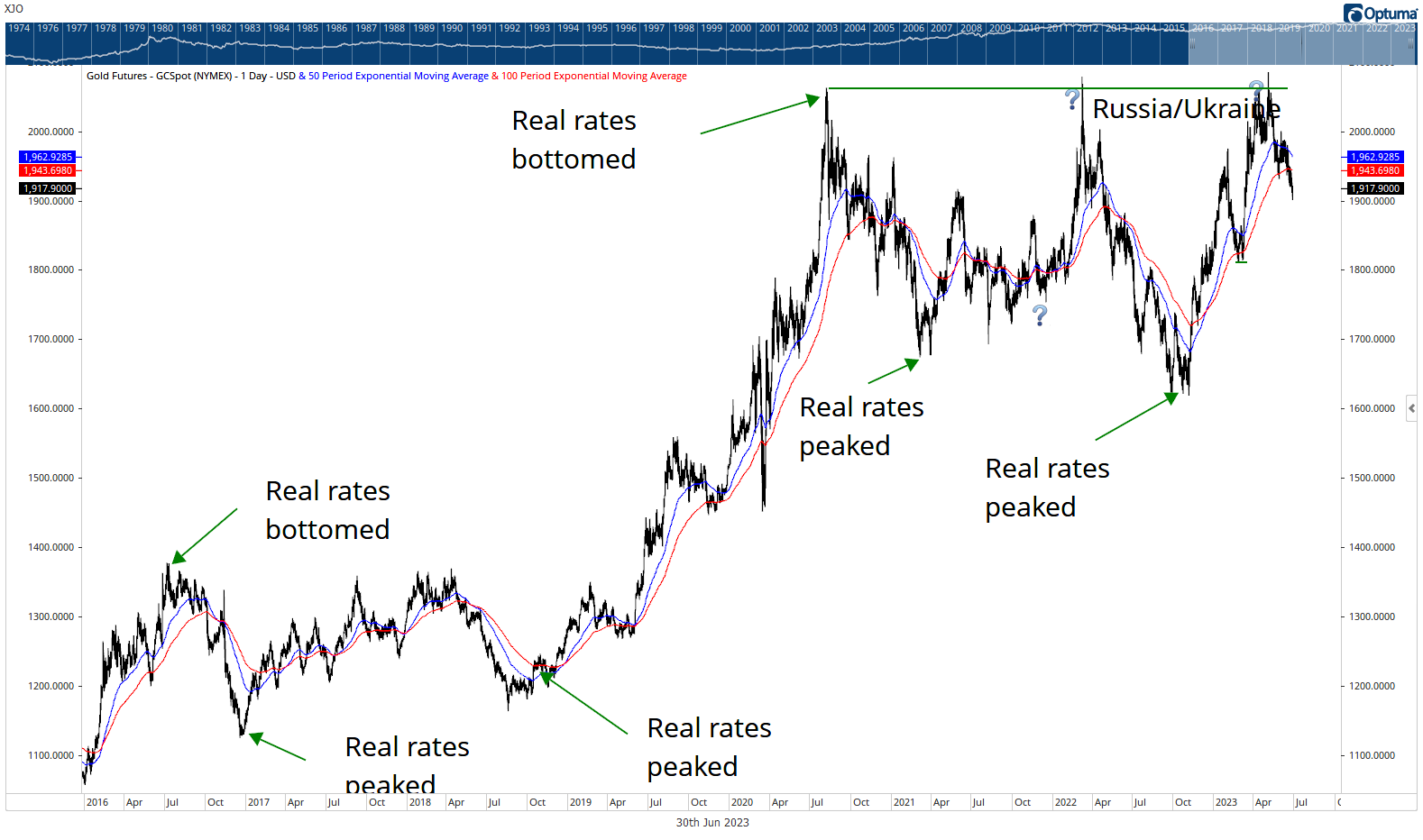What’s Not Priced In #6: Explaining the Gold Price Mystery
In the sixth episode of What’s Not Priced In, Greg Canavan and I explore the determining factor behind the gold price. It gets a little complex, but Greg’s insight is well worth it.
We also unpacked the latest inflation and retail sales data. Although a bunch of retail stocks rebounded this week, Greg doesn’t think you should get excited the bottom is in just yet.
We finished by looking at two stocks selling cheese and chicken. One of the stocks hasn’t aged nearly as well as a good cheddar.
You can check out the latest episode below.
Or you can listen on Spotify, Apple Podcasts, or your preferred platform.
Stories of the week: inflation, retail sales, and retail stocks
Did the monthly CPI indicator for May tell us anything new?
Headline inflation did surprise to the downside and the ASX 200 closed 1.1% higher on the day of the release. Maybe the Reserve Bank will hold off raising rates, the market thought!
Then the retail trade data for May dropped on Thursday.
Retail sales topped expectations, picking up from March and April. Even spending on discretionary goods got a boost.
That said, the Australian Bureau of Statistics’ Ben Dorber qualified the uptick (emphasis added):
‘This latest rise reflected some resilience in spending with consumers taking advantage of larger than usual promotional activity and sales events for May.
‘Just as we saw during the November Black Friday sales last year, consumers appeared to take extra advantage of discounting during large sales events in May in response to cost-of-living pressures.’
Businesses are discounting more than usual for May…and the savvy consumer is capitalising. We’ll see next month if the consumer — satiated on discounts banked in May — curbs spending in June.
Speaking of ‘larger than usual promotional activity’, I’m reminded of something I like to call Lowe’s Law:
‘If demand is strong, a business doesn’t discount. If a business does discount, demand isn’t strong.’
This ‘law’ comes from a comment Reserve Bank governor Philip Lowe made before the Senate in February (emphasis added):
‘On pricing, they [businesses] don’t say this, but when demand is strong, you don’t discount. If demand for your product is strong, why would you discount?’
Modus tollens, if you discount, demand isn’t strong.
So it was interesting to see the retail sales data release coinciding with a mini-rally staged by bombed-out retail stocks this week:
- Universal Store [ASX:UNI] is up about 15% this week
- Dusk [ASX:DSK] is up about 17%
- Adairs [ASX:ADH] is up about 18%
- Baby Bunting [ASX:BBN] is up about 15%
- City Chic Collective [ASX:CCX] is up about 20%
Is the bottom in?
We’re not confident. Greg showed the charts for these stocks and its peers during the podcast. Almost all are in deep downtrends despite the recent spike.
The time to go bargain hunting in the retail sector will come, just not yet.
As for where rates are headed, Greg doesn’t think the Reserve Bank should raise in July but admitted we are in the ‘higher for longer’ interest rate era (looks like we’re in the Taylor Swift era, too).
The risk is the market not fully pricing in the impact of protracted high interest rates on stocks.
Job vacancies remain high: recession, what recession?
Markets are forward-thinking. They are a discounting machine.
So giving undue weight to lagging indicators can be costly.
That’s why Greg wasn’t too fussed about the latest job vacancies data. Although I was.
While vacancies fell for the fourth straight quarter, vacancies for May were still nearly double those in February 2020 — pre-pandemic!
And the percentage of businesses reporting at least one vacancy remained over 20% since May 2021.

Should we care?
Maybe, if we think the Reserve Bank cares. And I believe it does. Here’s RBA deputy governor Michele Bullock speaking last week (emphasis added):
‘Our assessment is that, for the first time in decades, firms’ demand for labour exceeds the amount of labour that people are willing and able to supply. That is, employment is above what we would consider to be consistent with our inflation target.’
What moves gold?
Now to the main event of the episode, which was all about answering the question ‘what really moves the gold price?’.
Commodities legend Rick Rule once said it’s the US 10-year Treasury:
‘I think if you look at the real determinant of the gold price over the last 40 years, it’s been the popularity or lack of popularity of the US dollar and, in particular, the US 10-year Treasury.’
Rick Rule gets close to the truth. But as Greg explained in the episode, the full answer lies with real interest rates.
In the pod, Greg shows how you can calculate the real interest rate for yourself. The key is to use long-term inflation expectations in the calculation.
Chart of the week: gold and real yields
Here’s the chart whipped up by Greg to illustrate the tight relationship between real rates and gold:

So where is gold headed from here?
Greg is circumspect about gold’s near-term outlook. But to get his full thoughts, catch the episode!
Stocks of the week: chicken and cheese
Although the performance of these stocks is chalk and cheese, it’s chicken and cheese that this pair sells.
I’m talking about Collins Foods [ASX:CKF] and Bega Cheese [ASX:BGA].
Collins Foods surged this week, but Greg wasn’t too impressed with the stock’s stretched valuation.
As for Bega Cheese, well…
Watch the full episode on your preferred platforms for the discussion.
Hope you enjoy it.
4 topics
2 stocks mentioned
1 contributor mentioned
.png)
.png)